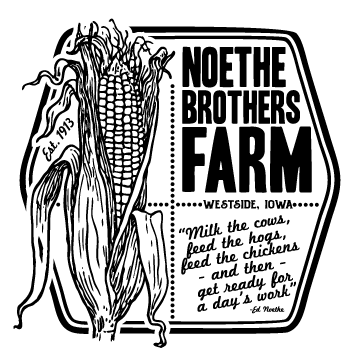
Farmland History
The Noethe Brothers Farm sits on Plat 13 of the Westside Township in Crawford County, Iowa. The land where the house sits was originally granted by the United States to the State of Iowa on May 15, 1856 . The land was granted to aid in the construction of a railroad. The State of Iowa granted the land to the Iowa Central Air Line Railroad Co. on July 14, 1856. The Iowa Central Air Line Railroad Company failed to comply with the terms of the grant. Subsequently, the land was granted to the Cedar Rapids and Missouri River Railroad Company in 1860. That company built the railroad through Westside. The Farmhouse was built in 1870... we aren't sure who built it, because the land was owned by the railroad.
Cedar Rapids and Missouri River Railroad Company
The railroad owned this land from 1860 - 1881, and the railroad was owned by John Insley Blair. John Blair was considered 'Namer of Towns' - he was a railroad builder in the state of Iowa and he was said to have laid out more than 80 townsites in the state. These site needed names, of course, and Blair named many towns after his family and associates. It appears than more than 20 Iowa towns owe their names to Blair, including Marcus, named after his son, Aurelia, named after his daughter, and Ames, named after a colleague. In his lifetime, he was president of 16 different rail companies, and one of the wealthiest men in America. At the time of his death in 1899, his estate was valued at about seventy-five million dollars, certainly one of the half dozen great fortunes of that day. A devout Presbyterian, Blair was frugal, hard working, fiscally responsible, and emphasized ownership of land. At one point, he owned two million acres of land, and was the largest landholder in the country. He was honored locally, for his occasional support of civic needs. His donations went to building about a hundred churches, and to Princeton University, Park, Coe, and Grinnell Colleges.

The Early Pioneers
1881-1894
According to the abstract - the farm changed hands many times after the railroad was completed.
-
Around 1880, a large portion of land was deeded to Annie C. and Ezra P. Savage. The current farm was part of this land. They held parts of the land and divided it among others until 1887. Ezra was a notable business man and worked in Lumber, Coal, Lime, Cement, Agricultural Implements, cattle, etc. He went on to a career in politics which included being the first Mayor of South Omaha, as well as the Governor of Nebraska from 1901-1903.
-
In 1883 - the name on the deed and plat book is Milton Santee. He was a land surveyor and engineer that was born in Pennsylvania and moved across the country, finally settling in California where a town is named after him. In 1885, Santee transferred the deed to the public.
-
Peter Beermaker purchased the farm in 1886 to give to his mother Magdalena. The farm was purchased in order for her to live comfortably the rest of her days. She passed away on Feb 20, 1889.
-
The farm was then purchased by Hans Holst in 1893. He owned the land for one year.
Clark Evison 1894
Clark Evison owned a large plot of land just north of where are farm is located. Evison purchased the current farmland from Hans Holst in 1894. He was born in England in 1842, immigrated to Clinton County, Iowa in 1853. Evison came to Westside in 1876 and is listed as one of the original settlers of the town (See Westside History post). For some time it was called "the Old Evison Farm".
Evison and his wife (Mary Welty) had 12 children, 7 of which survived. He sold the farm around 1903 and moved to Dallas County, where he passed away in 1920.

The Killeen Family 1903
In 1903 the farm was bought by Patrick Killeen. He is listed as the owner on the 1908 plat book. Now... there are TWO Patrick Killeens living at the time - a Sr. who died in 1909 at the age of 82, and a Jr. (Patrick Henry) who was 38 at the time of the sale... so more than likely - it was the Jr. Patrick Henry had 5 brothers all in the area. There are still members of the Killeen family in the area.
In 1912, Frank Noethe purchased the land on plat 13. He is the owner on the 1920 plat map. The news was published in the Denison Review on Wednesday, July 17 1912...



